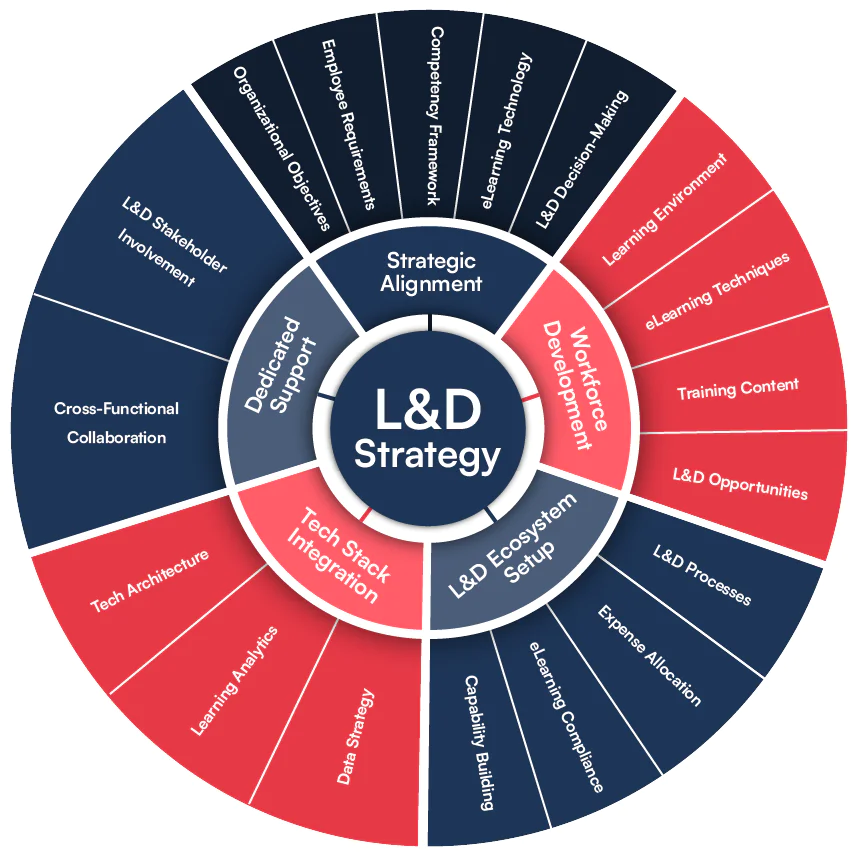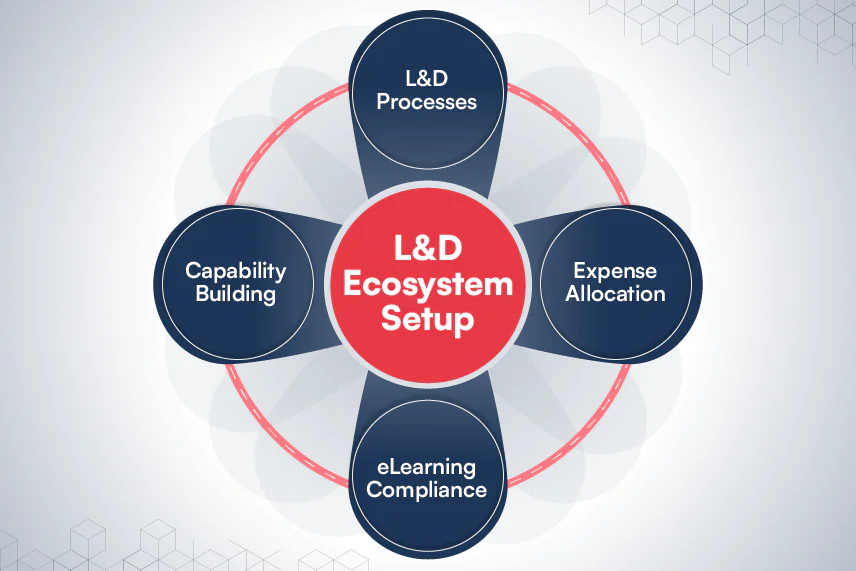
Having the right Learning and Development (L&D) strategy in place is essential for eLearning innovators looking to create seamless learning experiences and maximize business ROI. It will help curate personalized employee training programs backed by latest technologies like AI, self-paced eLearning modules, agile methodologies, and effective learning content assets.
As L&D professionals navigate the complexities of the ever-evolving talent landscape, they are witnessing a shift toward embracing ‘Internal Talent’. They are focusing on reskilling existing employees instead of hiring new ones, to eliminate additional costs. This changing dynamics demands a solid investment in learning and development strategy. It requires cost-effective training that meets immediate workforce needs and prepares employees for future roles.
This blog post underscores the significance of learning and development strategy and how it positively impacts workforce capabilities. It outlines the key elements to build a future-ready strategy for eLearning and business success. You will also come across real-world examples of learning and development techniques that delivered exceptional results for global organizations. Let’s begin.
What is a Learning and Development Strategy?
A learning and development strategy is a structured roadmap to align an organization’s training initiatives with its business objectives. It focuses on identifying the skills gap and implementing the necessary tools, technologies, and resources to close them. With targeted workforce development opportunities, this strategy aims to improve employee performance and drive organizational success.
A learning and development strategy combines various eLearning methodologies, educational programs, and training assessment and evaluation techniques to build learner-centric workplaces. It determines how L&D teams approach upskilling, leadership development, corporate eLearning, and continuous learning culture.
“A research report by DeakinCo. in partnership with Deloitte Access Economics states that every $1 invested in learning and development per employee is associated with an additional $4.70 in business revenue per employee on average.”
With a sophisticated learning and development strategy, organizations can effectively meet the skilling requirements of the modern workforce. They can overcome existing and future workplace challenges, streamline on-the-job training mechanisms, and support employee work journeys. Moreover, it becomes easier to outline eLearning focus areas, L&D stakeholder requirements, and measurable business outcomes.
5 Essential Components for Building Solid L&D Strategy
Now that you know what a learning and development strategy means, it’s time to understand the essential steps for building a winning strategy for your organization. Here’s a blueprint to help you get started.

#1 Strategic Alignment
This step involves identifying and prioritizing business, talent, and technology goals to drive learning and development strategy in the right direction. L&D professionals need to align eLearning development techniques with overarching corporate objectives for measurable outcomes.
A. Organizational Objectives
Embed learning and development initiatives within the core objectives of the organization. Align business KPIs with corporate eLearning milestones. Ensure every eLearning content development project drives a direct impact on business growth and metrics.
B. Employee Requirements
Conduct skills gap analysis to identify and address employee development needs. Tailor training offerings with employee preferences for enhanced learner engagement and retention. Focus on creating personalized learning pathways for faster skills acquisition.
C. Competency Framework
Develop a clear structure for assessing and nurturing key employee competencies. Adopt competency-based frameworks to optimize learning and development programs from foundation to advanced competency building. Regularly update these frameworks and track individual competencies to evaluate training effectiveness.
D. eLearning Technology
Determine and contextualize eLearning technology decisions that suit existing and future business goals. Adopt the emerging eLearning trends to ensure scalability and flexibility across your learning and development strategy. Prioritize user experience over standardized interfaces and value-based service delivery over a one-size-fits-all approach.
E. L&D Decision-Making
Strategize learning and development objectives to guide effective resource allocation for maximum impact. Facilitate agile decision-making to quickly adapt to organizational shifts and industry demands. Establish a holistic culture that outlines every aspect – business, talent, skills, and technology strategies.
#2 Workforce Development
This step is all about understanding the nitty-gritty of all the elements that directly impact employee training. These may include skilling platforms, eLearning programs, virtual team collaboration initiatives, compliance training, and evaluation mechanisms.
A. Learning Environment
Foster a learning and development culture where eLearning is an integral part of daily operations. Build an ecosystem that encourages ongoing employee development beyond formal training. Implement learning tools and systems to actively support peer learning, shared leadership, and collaboration.
B. eLearning Techniques
Curate a balanced mix of creative eLearning approaches that meet the learning requirements of the modern workforce. Implement hands-on training experiences that reflect real-world scenarios and challenges. Incorporate diverse learning styles, including interactive modules, gamification, and simulations.
C. Training Content
Design and develop easily accessible learning content for smooth transition from information-sharing to knowledge-application. Modernize legacy content and assets using AI to introduce advanced features and functionalities. Remove obsolete content to reduce overheads, improve compatibility with latest technologies, and enhance scalability.
D. L&D Opportunities
Ensure inclusivity in offering learning and development opportunities to all employees, including those with special abilities. Create eLearning environments that meet WCAG guidelines, Section 508 accessibility standards, and ADA principles. Provide diverse training programs that suit different backgrounds, work journeys, and career trajectories.
#3 L&D Ecosystem Setup
Design learning and development systems that streamline the delivery and management of eLearning initiatives. Create the right balance between employee training infrastructure and organizational workflows.

A. L&D Processes
Streamline all logistics tasks, including scheduling and resource management, for eLearning. Create feedback mechanisms to refine and optimize the execution of learning and development processes. Implement a vendor management strategy to ensure quality and consistency in training delivery.
B. Expense Allocation
Monitor learning and development spending based on strategic impact and ROI. Prioritize technical debt management to ensure budgets remain flexible to accommodate evolving learning needs. Invest in high-impact eLearning initiatives and reallocate resources swiftly to eliminate additional costs.
C. eLearning Compliance
Stay updated with industry regulations to ensure your eLearning content meets required compliance standards. Create internal audits to review and validate whether your learning and development strategy conforms to the essential eLearning standards. Maintain comprehensive documentation for error-free adherence to legal and organizational guidelines.
D. Capability Building
Invest in leadership development programs to equip L&D teams with necessary managerial skills. Encourage reskilling and upskilling to enable innovation and embrace digital transformation in eLearning. Establish clear roles and responsibilities for optimal efficiency.
#4 Tech Stack Integration
Strategize seamless integration of cutting-edge technologies with existing eLearning and organizational systems. Assess emerging eLearning content development tools and automation capabilities to refine and enhance your eLearning ecosystem.
A. Data Strategy
Establish a robust data infrastructure that supports L&D professionals in collecting, analyzing, and using data to drive eLearning initiatives. Track key metrics to observe overall business performance in tandem with learning outcomes. Regularly check for potential patterns and statistics to future-proof your learning and development strategy.
B. Learning Analytics
Utilize advanced learning analytics to identify, monitor, and assess areas of improvement. Develop continuous reporting mechanisms to track progress toward learning objectives. Leverage competency-based, team, and group analytics to measure the effectiveness of team-based eLearning programs and enable data-driven business decisions.
C. Tech Architecture
Build a cohesive tech ecosystem that helps navigate complex learning and development challenges. Integrate cutting-edge technologies, such as AI, NLP, and ML to deliver custom eLearning experiences. Harness the power of Agentic AI integration to automate repetitive tasks, streamline workflows, reduce development time, and ensure long-term cost savings.
#5 Dedicated Support
Construct a learning and development environment based on internal feedback and external support. L&D practitioners need to focus on collaboration and shared leadership to execute their eLearning strategy without compromising quality.
A. L&D Stakeholder Involvement
Engage internal stakeholders to curate feedback loops for gathering insights on training effectiveness. Incorporate leadership insights into decision-making to drive iterative improvements in your learning and development strategy. Establish clear communication channels to fine-tune this strategy.
B. Cross-Functional Collaboration
Communicate workforce development objectives across all levels of the organization. Maintain optimal symmetry across eLearning goals and other departmental objectives to create a cohesive learning and development strategy. Encourage the sharing of resources, expertise, and knowledge to enhance learning outcomes.
C. Partnership with eLearning Experts
Partner with a trusted eLearning technology and content solutions provider to adopt advanced technologies and methodologies for eLearning and business success. Collaborate with eLearning experts specializing in gamification, AI-based learning solutions, and custom content development and modernization. Leverage their expertise to unlock the true potential of rapid automation and integration, learning design, nudge learning, microlearning, eLearning accessibility, translation, and localization.
Practical Examples of Learning and Development Strategies
After understanding the roadmap to design and develop an impactful learning and development strategy, let’s move forward to exploring some real-life examples. These case studies highlight how learning and development strategies have helped leading organizations enhance workforce capabilities and improve business productivity.
Learning and Development Strategy Example 1
A renowned organization specializing in heavy vehicle driver training sought to close the skills gap, provide learner-centric training, and personalize learning experiences. They approached Harbinger to overcome complex challenges like low workforce performance, low learner engagement, and improper alignment of skills with business needs.
Harbinger helped our client create a custom learning and development strategy to introduce a targeted training program. We used our competency-based learning framework to deliver effective learning content for bridging individual competency gaps. Our solution ensured the safety of heavy vehicle drivers, improved driving performance, and enhanced learner satisfaction score.
To know more about our solution and its impact, download success story.
Learning and Development Strategy Example 2
An eminent technology institute was looking to automate custom content development for their educational and research programs. They collaborated with Harbinger to fast-track the process of creating video-based eLearning course assets, reduce development cost, and deliver custom designed learning experiences.
Harbinger enabled our client to change their learning and development game using AI. We implemented an AI-powered Harbinger IP framework, OpenAI GPT-4 Turbo, Synthesia, and a trained LLM to achieve 80% automation of eLearning content creation. Our solution minimized overheads, increased accuracy of video content and curricula, and reduced manual efforts by 75%.
Here are some screenshots of the final avatar-based course video:
To know more about our solution and its impact, download success story.
Learning and Development Strategy Example 3
A global healthcare products and services provider wanted to advance blended learning for their medical sales team spread out in different locations. Their aim was to establish a learning and development strategy backed by latest technologies, efficient training content delivery, consistent eLearning content, and robust performance assessment.
Harbinger assisted our client in designing and implementing gamification in sales training. We deployed engaging SCORM 1.2 compliant gamification modules to enhance blended learning. Our team introduced interactive gamified elements like scores and well-being indicators to boost learner competencies and productivity. The solution created a self-paced eLearning environment and was rated helpful by 100% learners.
To know more about our solution and its impact, download success story.
Parting Thought
The success of a learning and development strategy lies in its measurable impact: an agile, engaged, and future-ready workforce driving sustainable business growth. With data-driven insights, learner-centric approaches, and advanced technology integrations, L&D stakeholders can create meaningful learning experiences that go beyond preset workforce training paradigms.
If you are looking to build a transformative learning and development strategy to dominate the ever-evolving skill-building and talent development landscape, write to us. Our eLearning and technology experts will help you exceed key business goals and outshine your competitors like never before.




